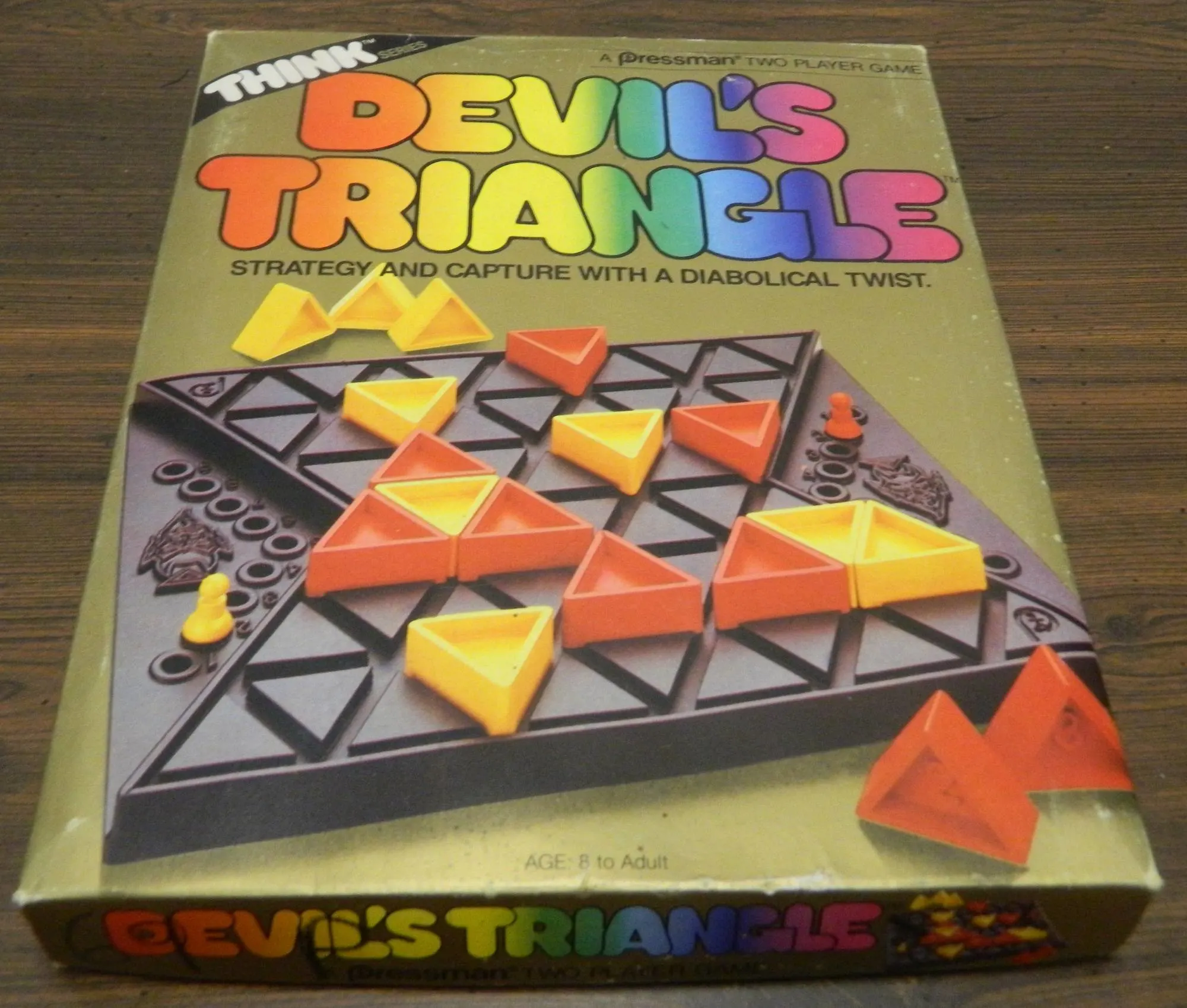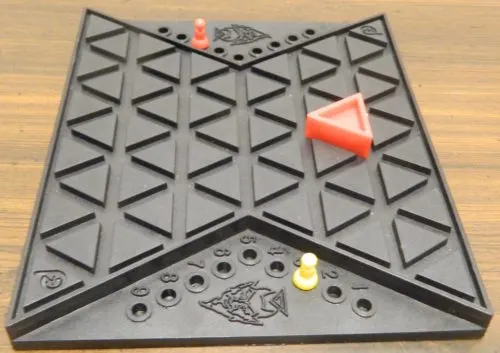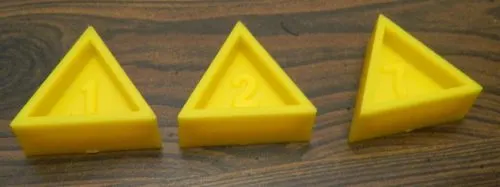Back in the 1980s the Pressman Toy Corporation launched the Think Series. The Think Series was a line of abstract strategy games and puzzles that were focused more on the gameplay than their visual appeal. While I have acquired quite a bit of the Think Series over the years through rummage sales and thrift stores I had yet to play any of them. Well today I am going to start my look at the series withDevil’s Triangle. At first glance Devil’s Triangle looks like your typical abstract strategy game but you quickly realize that the game has some serious issues.
How to Play Devil’s Triangle
Setup
- Each player chooses a color and takes the peg and triangles of that color.
- Each player chooses a number between one and nine and places their peg into the corresponding hole on their side of the board. This number will be the player’s devil.
- Each player randomly chooses one of the triangles at random (numbers face down). The player who draws the higher number will get to place one of their triangles first. The chosen triangle is turned face down on the table with the rest of the triangles.
- Players take turns randomly choosing one of their triangles and placing it (number side down) on the gameboard. When placing a triangle it can be placed on any open space on the gameboard.
- When all of the triangles have been placed on the gameboard, the game begins.
Playing the Game
On a player’s turn they will pick up one of their triangles from the gameboard and move it to any other open space on the gameboard. A player can choose to move any triangle that has at least one side that doesn’t have a triangle next to it.
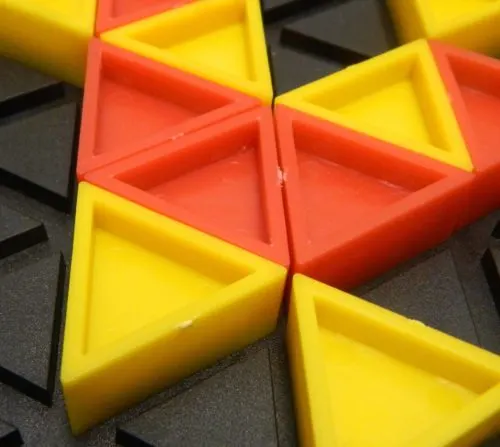
The red triangle that is surrounded by triangles can’t move until one of the triangles surrounding it are moved.
The objective of the game is to capture the other player’s triangles. A player captures a triangle by moving one of their triangles to a space that leads to them surrounding a triangle controlled by the other player. When a triangle is captured it is removed from the gameboard and is placed in front of the player who captured it. The triangle is flipped over. If the number on the triangle matches the other player’s devil, the player who captured the triangle automatically loses the game. Otherwise the game continues as normal.
Triangles can only be captured when the capturing player moves one of their triangles to one of the spaces next to the captured triangle. A player can move one of their own triangles to a space that is surrounded and it won’t be captured. This triangle can’t be moved though until one of the surrounding triangles have been moved.
Once a player has moved one of their triangles the other player takes their turn.
End of Game
The game can end in one of two ways.
If a player captures the other player’s devil triangle, they automatically lose the game.
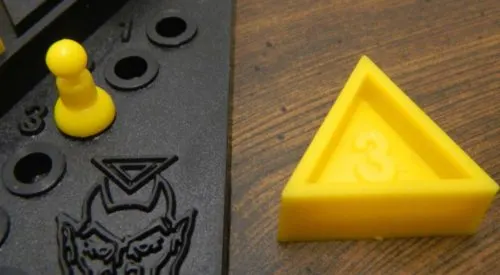
The red player has captured the yellow three triangle. As this triangle was chosen as the devil’s triangle the red player has lost the game.
Otherwise the first player to capture three of the other player’s triangles wins the game.
My Thoughts on Devil’s Triangle
When I review games I like to talk about both the positives and negatives. When it comes to Devil’s Triangle though it is not quite so easy as to be honest there aren’t a lot of positives to take from the game. Basically the only positives I can come up with for the game is that it is quick and easy to pick up and play. The game is really straightforward where you can teach it to a new player within just a couple minutes. The game is also quite short at only five to ten minutes.
The problem with Devil’s Triangle is that it feels like it was never fully play tested. I can see what the designers were trying to do but it doesn’t work properly. The main gameplay mechanic feels broken. Basically players take turns moving their triangles around the board trying to capture the other player’s triangles. Players are trying to move their triangles to a position which will surround one of the other player’s triangles. At first this seemed like a decent mechanic as it is similar to a lot of other abstract games. It actually sounded like it could have made for a good game.
The problem is that in execution it doesn’t work. I think the main reason why it doesn’t work is that there are few restrictions on movement. You can move any triangle that has at least one free side to any empty space on the board. This allows you to move almost any triangle to anywhere on the board. This leads to problems as it makes it quite hard to capture the other player’s triangles. When you put a triangle in position to capture another player’s piece they will just move that triangle to another spot on the board. This back and forth continues throughout the game. Basically the only way to ever capture one of the other player’s pieces is to take advantage when they make a mistake. Thus the first player to make three mistakes will lose the game.
This problem is not helped by the fact that the first player seems to have a pretty big advantage in the game. I think the first player has an advantage since they will get the first move after all of the pieces have been placed. This gives them a good chance of finding a way to capture one of the other player’s triangles. Since they then have a one triangle advantage it gives them an advantage in capturing triangles on future turns. The other player is also likely forced into playing defensively which leads to the problem of players constantly moving their triangles out of harm’s way.
The dumbest mechanic in the game is the game’s namesake the “devil’s triangle”. Basically the premise is that both players choose a triangle that will act as their devil’s triangle. If the other player captures this triangle they automatically lose the game. The devil’s triangle basically acts like a trap that the other player has to avoid. In theory this wouldn’t be a bad mechanic as it would force players to be cautious while capturing the other player’s triangles. Players could try to trick one another into capturing their devil’s triangle which would lead to players never knowing for sure what the other player was up to.
The problem is that the game doesn’t allow the players to know what number any of the triangles are until they are captured. Therefore the players are unable to trick the other player since they themselves don’t know what number any of the triangles are. Players can only capture triangles and hope they don’t capture the triangle that automatically loses them the game. The mechanic ultimately adds luck to the game as a player could be winning the game and then randomly choose the one triangle that automatically loses them the game.
Now you could easily fix this rule by allowing the players to look at the numbers on their triangles before they place them and throughout the game. This would allow a player to know which triangle is their devil’s triangle and manipulate the other player into capturing it. While this would make the mechanic a little better, I don’t think it would drastically improve it. There would be some strategy in trying to get the other player to capture your devil’s triangle. Unless you are really good at reading the other player it is still going to feel pretty random whether you pick a devil’s triangle or not.
While I wouldn’t consider myself to be a huge abstract strategy game fan, these issues lead to Devil’s Triangle being a boring game. I think this is the biggest problem with the game. Devil’s Triangle is just not a very fun game. You basically do the same things over and over again until someone ultimately wins. Usually these type of abstract games overcome the somewhat dull gameplay with strong strategic gameplay where you can outsmart the other player. For the most part is just seems like in the Devil’s Triangle you have to rely on the other player messing up. That doesn’t make for a compelling board game.
On the component front the game is the definition of solid but unspectacular. The components for the most part are pretty durable as they are made of pretty thick plastic. They aren’t much to look at though as they are quite bland. I also don’t know if this was just a problem with the copy I found but it had two of the same numbered triangle for one of the colors. I am guessing that this was just an uncommon error but it did impact what numbers we could choose for the devil’s triangle.
Should You Buy Devil’s Triangle?
Before playing the Devil’s Triangle I had some hope for the game. I didn’t think it was going to be fantastic but I thought it would be a decent abstract strategy game. After playing Devil’s Triangle I have to admit that the game feels like a broken mess. While the game is easy to learn and quick to play, there really aren’t any other positives for the game. The main gameplay mechanic leads to players running away when someone gets close to capturing one of their pieces. This leads to only being able to capture another player’s triangles when they make a mistake. Then you add in the devil’s triangle mechanic which solely adds luck to the game. What you are left with is a boring game that you can argue is broken.
Unless you love abstract strategy games I would recommend staying far away from the Devil’s Triangle. Even if you like abstract games I still likely would not recommend Devil’s Triangle. The game has too many problems to recommend playing it under its official rules. With some extensive house rules though you may be able to salvage the game. For this reason though I would only recommend picking it up if you don’t mind tinkering with the rules and find the game for really cheap.
If you would like to purchase the Devil’s Triangle you can find it online: Amazon, eBay

